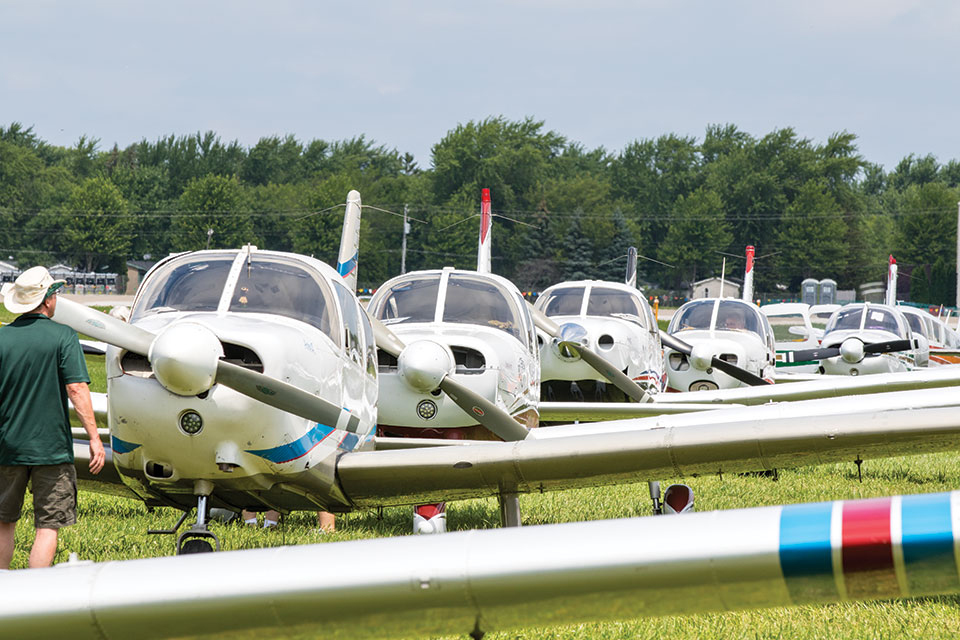AirVenture Arrival Procedure Changes Recommended to FAA
November 15, 2018 - A number of significant changes to the EAA AirVenture Oshkosh arrival procedures are being recommended by EAA to the FAA to create better staging and safety margins for incoming aircraft to Oshkosh. These recommendations are based on the annual review of air traffic operations and from feedback by pilots using the 2018 procedures.
“The weather situation on the weekend prior to AirVenture’s opening day last year revealed several areas where air traffic procedures could be improved,” said Sean Elliott, EAA’s vice president of advocacy and safety. “We included pilot feedback in the working group review we created this fall, with the group’s recommendations going to the FAA this month as the agency has final determination on air traffic procedures for AirVenture.”
The review working group included those with expertise in GA safety, homebuilt aircraft safety, air traffic control, and mass arrival processes. The group contained many members of EAA’s Safety Committee and various councils. It met weekly over the past several months to review current operations and opportunities for improvement.
The draft recommendations, which were briefed to EAA’s board of directors last week, encompass three areas to be addressed: procedure changes recommended to FAA, process improvements and education by EAA to pilots, and EAA and FAA working together to find innovative air traffic control methods for AirVenture.
“In 2018, weather systems during the three days prior to AirVenture’s opening day kept many pilots from making their final inbound flights to Oshkosh until the weather cleared on Sunday afternoon, July 22,” Elliott noted. “That brought a huge wave of inbound flights to Oshkosh in a short six-hour period that afternoon. While the controllers and ground personnel did yeomen’s work to park 3,000 aircraft within a six-hour period, there are ways to do it better.
“Added to that, water-saturated ground areas at Oshkosh after landing made arrivals more complex, as did mass arrival groups and a large number of aircraft that had extended holds. All of those factors were considered in the draft recommendations to FAA.”
Among the recommendations are:
Arrival Procedures (FAA Operations)
- Creating a new arrival gate (VFR waypoint, GPS and visually identified) that is further out than Fisk in order to facilitate consistent spacing prior to arrival at Fisk.
- A new depicted (GPS defined waypoints) VFR Fisk arrival overlay that is for marginal VFR weather (1,000- to 1,500-foot ceilings) operations. Aircraft that will be allowed to use this procedure must be ADS-B Out equipped.
- A raised minimum ceiling for all other aircraft operations on the Fisk arrival to 1,500 feet AGL.
- A procedure to address temporary airport closures and provide a “bail out” track that enables an orderly transition from the final inbound leg to KOSH to KFLD. Aircraft arriving KFLD along the defined route will either land at KFLD or be directed back to the initial for KOSH depending on airport closure status.
- –The FAA should create a revised policy for mass arrivals that restricts the arrival day/time to the planned time only with limited ability to shift due to weather. If the arrival slot is unsuitable due to weather at the designated time (mass arrival group is airborne) of the slot, then the mass arrival group should split up and arrive via the normal NOTAM procedure.
EAA Process Improvements
- Expand aircraft parking to the south and improve parking management strategies to maximize use of the space. By 2020, EAA will achieve a “no aircraft turned away” condition for general aviation camping parking, weather and ground water saturation concurring, and explore means (e.g., a potential reservation system or other incentives) to shift arrivals to days with lower volume.
- An extensive educational campaign to highlight arrival informational tools, weather planning and preparedness, and best practices during arrival operations. Distribution will include a potential online training course (with incentives), Chapter Video Magazine, online webinars, EAA magazines, EFBs like ForeFlight, and other web resources. Member incentives for participation in training/education will be developed.
- A text messaging arrival update tool for ATC that will be available to attendees.
- Work with the FAA to create an overhead break protocol that enables ATC to determine if overhead operations can be authorized at any given time.
- Encourage military aircraft to favor arrivals during air show waivered airspace times.
Joint FAA/EAA Actions
- Progressively integrate new technologies (GPS, ADS-B, TIS-B, etc.) into the AirVenture arrival procedures and aircraft identification as a multi-year, phased initiative to enhance safety and increase capacity.
- Education and incentive opportunities that may earn portions of WINGS credits.
“The input of pilots who flew the Oshkosh arrival in 2018 played a major role in these recommendations,” Elliott said. “We personally contacted nearly all of the pilots who sent input directly to us to better understand what they experienced and where the procedure could be improved.”
The recommendations will be forwarded to FAA officials for review by the end of November. Approved recommendations will be included in the AirVenture 2019 NOTAM. Additional input can be made through November 27 at feedback@eaa.org (please include your name and EAA member number with your communications).

